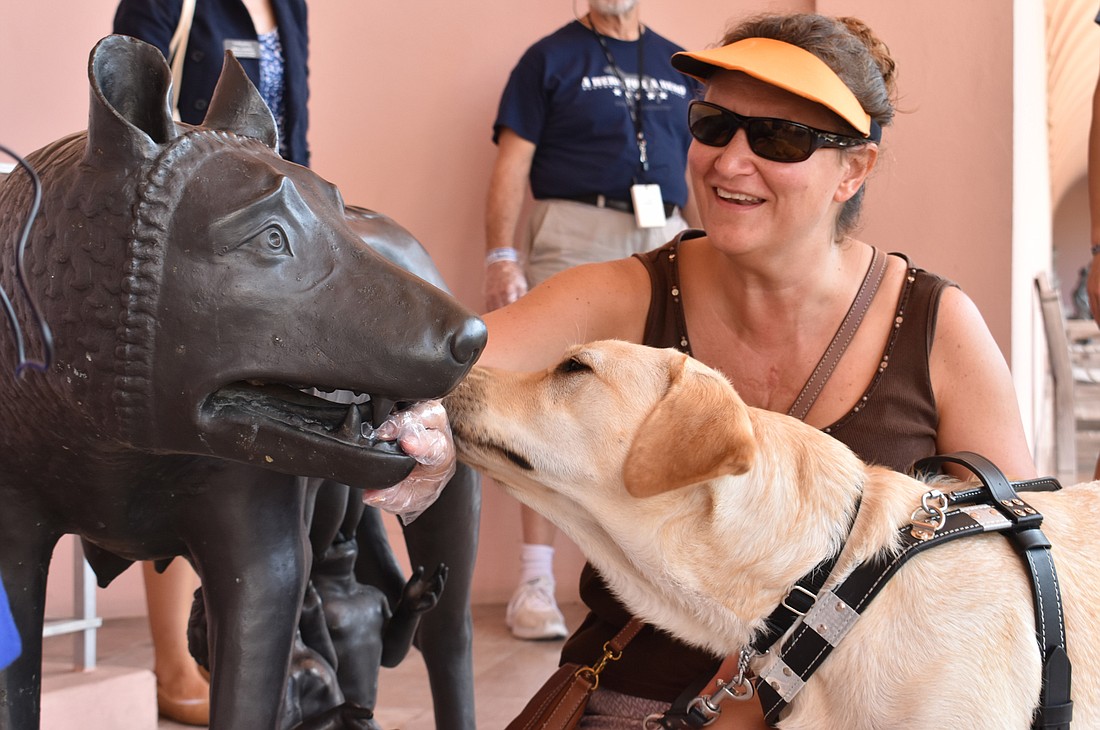- April 24, 2024
-
-
Loading

Loading

Art can be experienced in many ways.
A play can be watched, but it can also strike a chord in your heart. Music can be heard, but it can also get you up on your feet, moving to a beat.
The same goes for the visual arts, and a new partnership between The Ringling and Southeastern Guide Dogs is proving paintings and sculptures can be felt without being seen.
On Aug. 17, a sea of brown, white and black paws strolled across the tile floor of The Ringling entrance for the museum's first tour for people with visual impairments.
After she heard an NPR story in January about art museums creating experiences for individuals with visual handicaps, Southeastern Guide Dogs Director of Admissions and Alumni Services Suzy Wilburn got in touch with The Ringling education department. Her goal was to help the museum design a tour for people with vision impairments, and more specifically, new handlers who are learning to live with a guide dog.
For Wilburn, the mission carries special meaning.
“I am also visually impaired,” she says. “I did not visit a museum for nearly 13 years after losing my vision. I think this opportunity will show our students that they don't need to lose the culture in their life, just because they've lost their vision.”
Museum staff was looking for ways to be more inclusive, so they say they were thrilled to design a tour.
Soon after, Wilburn and Southeastern Guide Dogs Manager of Media Relations Ruth Lando met with representatives from the The Ringling’s educational staff to plan. It was important to Wilburn and Lando that the tour be as descriptive as possible and include opportunities for handlers to use other senses to experience a piece of art that’s typically only experienced visually.
Wilburn also trained the museum’s security guards and docents on how to interact with people with varying disabilities.
She says she is ecstatic with the tour The Ringling team designed.
“They were very interested in doing things the right way for our students,” Wilburn says. “The Ringling staff took the information and ran with it. They designed a descriptive tour that was world-class.”
The inaugural tour on Aug. 17, at the John and Mable Ringling Museum of Art, was dog themed, appropriately. Tour guide Laura Steefel-Moore took several handlers and their guide-dogs-in-training — who were to graduate from the 21-day program the next day — through several rooms in the museum, stopping at paintings and one sculpture that featured dogs in their imagery.
She described each painting in detail and asked the handlers to participate in the experience by making certain sounds, touching particular fabrics or answering questions related to the different symbols in every piece.
The handlers smiled throughout the descriptions of oil paintings in several wings of the museum, but the part their dogs seemed to enjoy the most was viewing — and touching (with gloves) — a canine-like statue outside in the courtyard. One dog found the statue of the Capitoline Wolf with Romulus and Remus so lifelike it felt inclined to bark at the statue just in case it posed a threat.
Lando says the goal is for all the handlers in their program to experience an hour-long tour at The Ringling as part of their training with their guide dog. The tours will eventually be available for others who are visually impaired.
Southeastern Guide Dogs trainer Chrissy Placido says even though these dogs had never been to the museum before, they’re prepared to handle any challenges posed by stairs and other obstacles because of the intensive training they undergo beginning as puppies. They learn how to guide their handler through all types of environments, both familiar and foreign.
Handler Rick Perry took the tour with his dog, Georgia, and says he found it both interesting and impressive, especially because it’s something he never thought he would be able to do.
“It was a learning experience that I wouldn’t have had wandering through,” he says. “I’m walking away with a better understanding and appreciation for art.”
Perry says experiences like this help him live beyond his disability.
“When you lose one of your senses, you draw back into yourself. But your dog brings you out.”